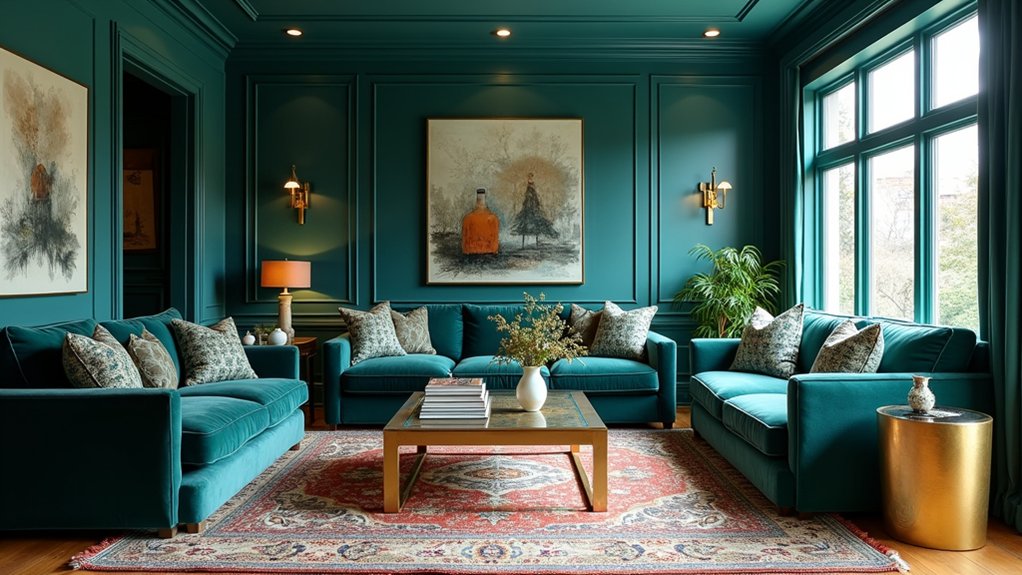
16 Teal Living Room Color Scheme Ideas That Are Bold Yet Soothing
Teal anchors bold yet soothing living room palettes through nuanced pairings with eggplant purple, mustard yellow, blush pink, cayenne red, cream, tangerine orange, pale blue, cognac, and navy blue. Designers employ layered textures, metallic accents, and varied chromatic intensities to achieve balance between vibrancy and calm. These visually dynamic schemes reflect current trends in maximal color and tactile depth, offering a range of sophisticated, expressive environments. A wider palette of ideas further expands teal’s versatility and appeal.
Key Takeaways
- Pair teal with gray tones for a sophisticated, calming palette that balances vibrancy with subtlety.
- Combine teal and mustard yellow to create a bold, energetic living room with warm, inviting accents.
- Use teal and blush pink for a serene, modern space softened by gentle pastel contrasts.
- Layer teal with navy blue or mint green for a tranquil, cool-toned scheme that feels both fresh and relaxing.
- Mix teal with earthy hues like cognac or eggplant purple for a rich, jewel-toned look that’s both bold and soothing.
Teal and Eggplant Purple
A well-curated blend of teal and eggplant purple establishes a sophisticated jewel-tone palette, increasingly favored in contemporary living room design. This color combination leverages the deep richness of eggplant purple against the calming vibrancy of teal, generating visual intrigue through dynamic contrast. Teal and grey serve as foundational hues, with grey providing a neutral backdrop that allows jewel tones to command attention without overwhelming the space. Brass accents introduce an additional layer of opulence, elevating the ensemble with a polished metallic sheen. Integrating wooden elements tempers the boldness of teal and eggplant purple, infusing warmth and organic texture. This palette is particularly effective in moody interiors, where layered color depth and contrasting materials create an inviting, luxurious, and visually cohesive living room environment. To further enhance the luxurious atmosphere, consider incorporating statement lighting fixtures that act as art pieces, adding ambiance and highlighting design elements.
Teal and Mustard Yellow
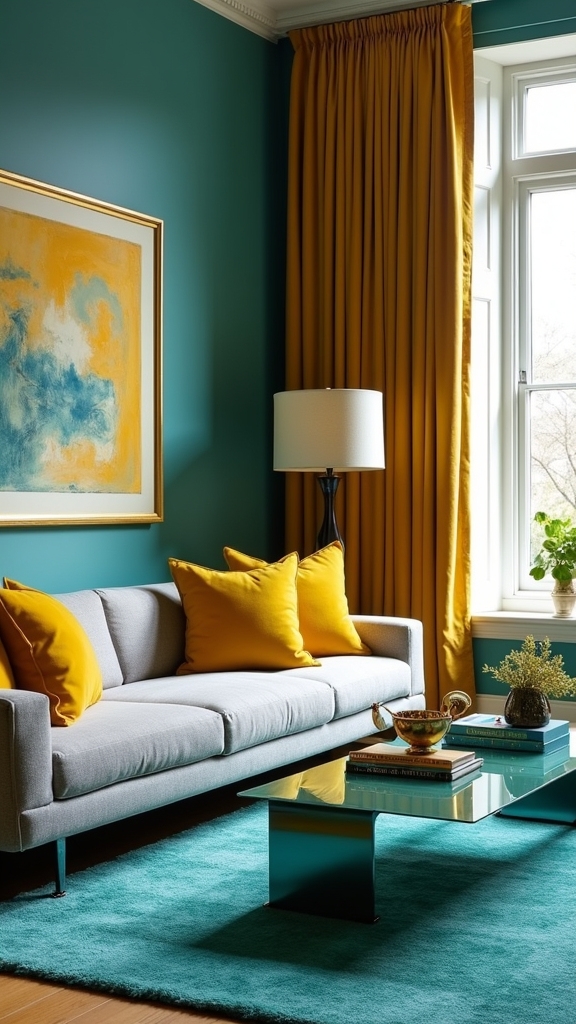
Shifting from the opulence of teal and eggplant purple, the pairing of teal and mustard yellow introduces a vibrant interplay of saturated hues that infuse living rooms with energy and warmth.
This dynamic color combination exemplifies contemporary teal living room ideas, where deep teal walls or sofas set a luxurious backdrop for the golden vibrancy of mustard yellow accessories.
The juxtaposition of these tones creates visual depth and an engaging focal point, ideal for modern and eclectic interiors seeking both boldness and cohesion.
Combining teal and mustard yellow brings striking depth and a captivating centerpiece to interiors that crave vibrancy and unity.
Integrating green velvet accents further enhances the scheme, imparting sophistication and tactile interest.
Mustard yellow cushions, vases, or abstract artwork provide balance, tempering teal’s intensity while maintaining a harmonious palette.
Incorporating metallic accents such as gold or brass can elevate the design, adding luxury and sophistication to the living space.
This trend-forward approach guarantees a visually stimulating yet inviting living space.
Teal and Blush Pink
When paired thoughtfully, teal and blush pink establish a nuanced color dialogue that merges teal’s tranquil depth with the subtle warmth of blush pink. This harmonious combination is increasingly favored in trend-forward interiors, where balance and visual interest are paramount. Teal’s rich undertones anchor the space, while blush pink introduces softness and an inviting charm, ideal for crafting cozy reading nooks or intimate settings. Strategic use of blush pink accents—such as textiles, artwork, or decorative objects—elegantly tempers teal’s intensity, fostering a serene yet sophisticated living room environment. Incorporating crisp whites or verdant green accents alongside teal and blush pink can further invigorate the palette, adding freshness and vibrancy. This versatile scheme adapts seamlessly across both modern and vintage-inspired design narratives. To enhance the ambiance even further, consider layering brown tones and textures like velvet or suede with teal and blush pink to add depth and richness, creating a truly unique and visually captivating space.
Teal and Cayenne Red
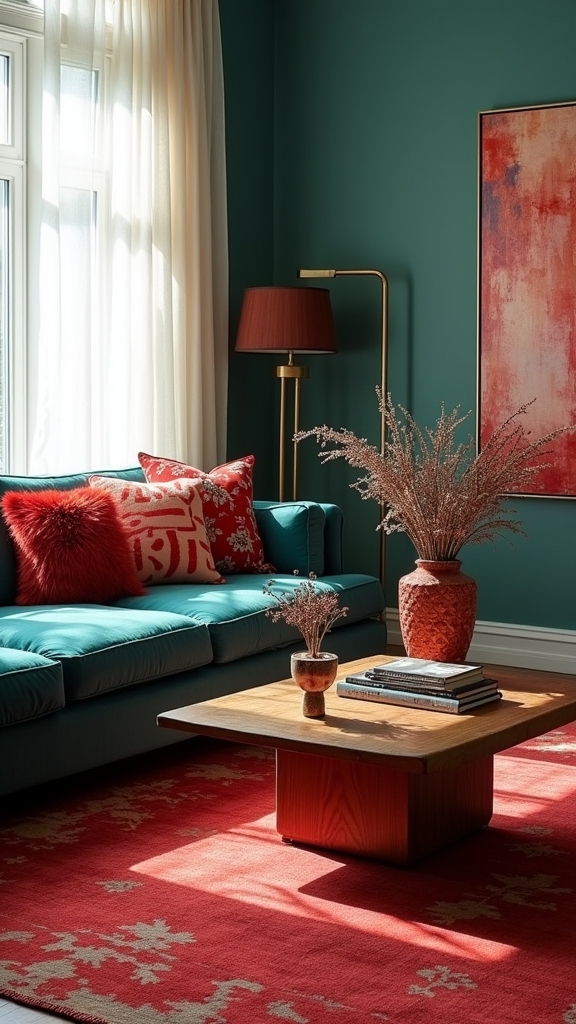
Velvet upholstery in teal juxtaposed with cayenne red accents infuses a living room with dynamic energy and visual intrigue.
The interplay between teal’s tranquil depth and the vivacious punch of cayenne red is particularly effective in eclectic interiors, where color contrast propels the narrative. Teal, when used as a dominant base on walls or key furniture, anchors the space, while cayenne red appears in strategic bursts—think cushions or curated artwork—for immediate visual impact.
This pairing finds further sophistication in the presence of dark woods such as mahogany, which ground both tones and foster cohesion. For balance, introducing neutral hues like white or beige can temper the palette’s intensity.
Incorporating light-colored throws can enhance the brightness of the room, creating a balanced and inviting atmosphere.
- Teal walls paired with cayenne red accessories
- Mahogany furniture accentuating both shades
- Bold artwork integrating both colors
- Neutral textiles to soften the scheme
Teal and Cream
While the dynamic interplay of teal and cayenne red energizes a space, a teal and cream palette offers a refined alternative that emphasizes sophistication and calm.
The juxtaposition of deep teal walls with cream furnishings foregrounds the rich, jewel-toned vibrancy of teal while utilizing cream’s understated warmth to balance the overall visual weight. Designers frequently incorporate cream accents—such as plush throw pillows or textured area rugs—to soften teal’s intensity, cultivating a serene yet inviting ambiance.
Deep teal walls paired with cream furnishings create a balanced, inviting atmosphere, where vibrancy meets soothing warmth for timeless elegance.
The adaptability of the teal and cream scheme suits both modern minimalism and classic interiors, signaling its enduring relevance in contemporary design trends. Incorporating natural materials like wood and linen into the design further enhances the cozy and elegant atmosphere of the living room.
Moreover, this versatile foundation invites curated accent hues, like mustard or gold, to amplify dimension and create nuanced focal points, ensuring a dynamic yet harmonious living room aesthetic.
Teal and Red
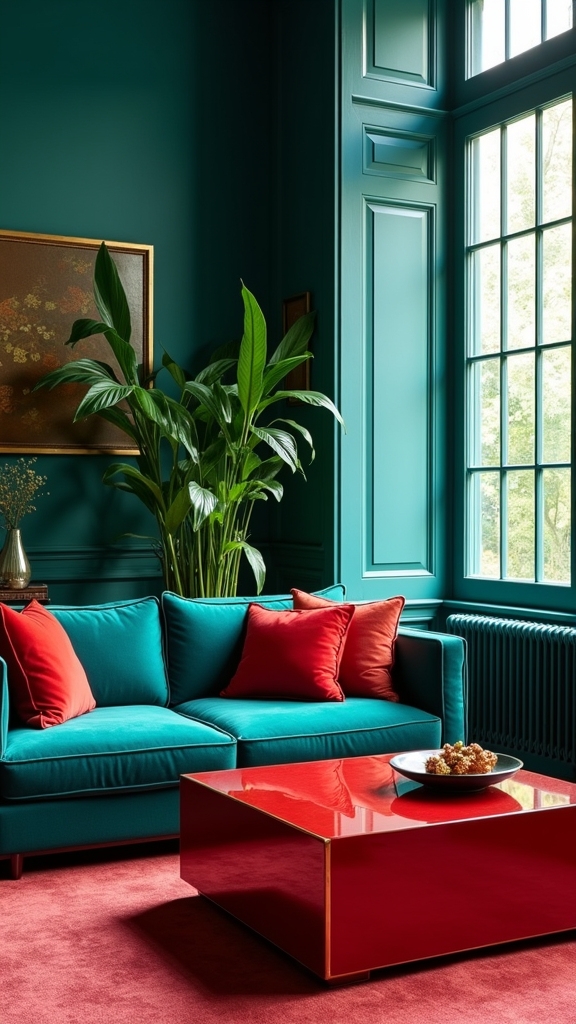
Although often seen as a bold choice, the teal and red color scheme delivers a visually arresting interplay that injects immediate energy into a living room.
Teal might anchor the space with its rich, cool undertone, while vibrant red accents punctuate the palette, creating a dynamic equilibrium. Designers frequently recommend deeper teal hues paired with saturated reds for a sophisticated impact, while lighter teal might temper the intensity, lending a playful yet refined atmosphere.
To prevent visual overload, neutral elements such as white or cream are essential, offering moments of repose within the scheme.
Eclectic interiors particularly benefit from this pairing, as layered patterns and tactile textures amplify the contrast.
- Deep teal and bold red create dramatic focal points
- Lighter teal might introduce subtlety
- Neutral accents prevent overwhelm
- Playful patterns highlight the color interplay
Teal and Gray
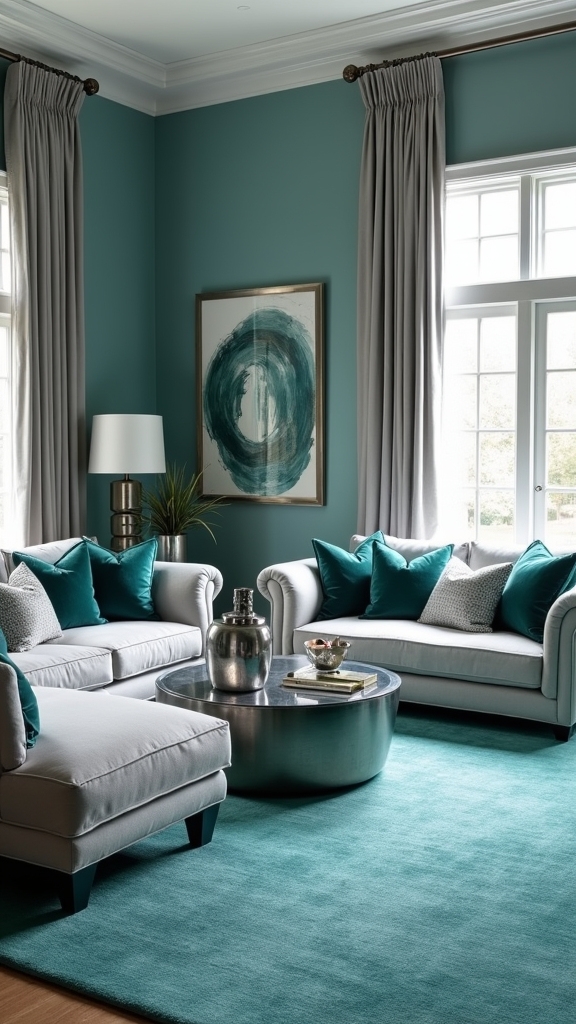
Serenity defines the teal and gray color scheme, where cool undertones merge to produce a balanced and sophisticated living room aesthetic. This contemporary palette leverages the calming properties of gray to temper the vibrancy of teal, establishing a tranquil yet visually compelling environment. Designers often recommend slate gray flooring paired with teal accents for a cohesive, modern look. Integrating gray furniture against teal walls or decor further unifies the scheme and introduces depth. For those seeking a moody yet inviting ambiance, a monochromatic palette with layered shades of teal and gray maintains visual interest and sophistication. Incorporating multi-functional furniture like storage ottomans or convertible sofas can enhance both the aesthetic and practical aspects of a teal and gray living room. The following table highlights practical combinations for this trend-forward color scheme:
| Element | Recommended Approach |
|---|---|
| Flooring | Slate gray with teal accents |
| Furniture | Gray pieces, teal accessories |
| Wall Treatments | Teal walls, gray decor |
Teal and Coral
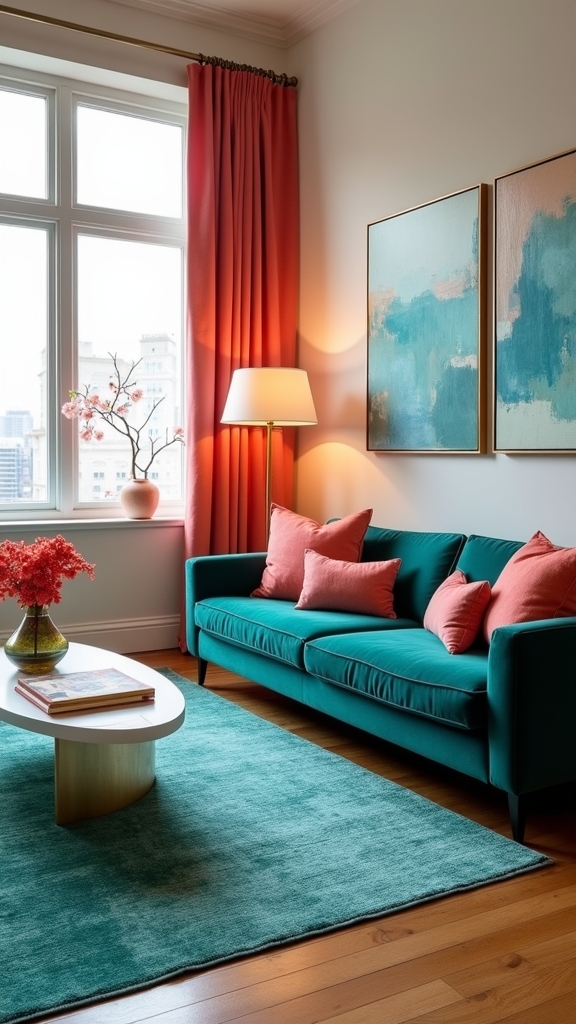
Vibrancy defines the teal and coral color scheme, delivering a dynamic interplay between cool and warm tones that enlivens any living space. The saturated depth of teal merges seamlessly with the vivacity of coral, yielding a contemporary palette that captures current interior design trends. This duo maintains equilibrium—teal’s tranquil undertones are animated by coral’s exuberant energy, preventing visual monotony. Strategic placement of coral accents against a teal backdrop guarantees focal interest without visual overload. Neutral furnishings, such as white or beige, anchor the scheme and enhance its sophistication. Incorporating organic textures—think wood finishes or indoor greenery—amplifies the layered effect, creating an inviting atmosphere. To further enhance the ambiance, consider the psychological impact of yellow with gray, as these hues add warmth and positivity to the overall color scheme. Teal walls with coral throw pillows or art for contrast. White or beige furniture to balance bold hues. Wooden accents for warmth and depth. Greenery to enhance freshness and dimension.
Teal and Bubblegum Pink
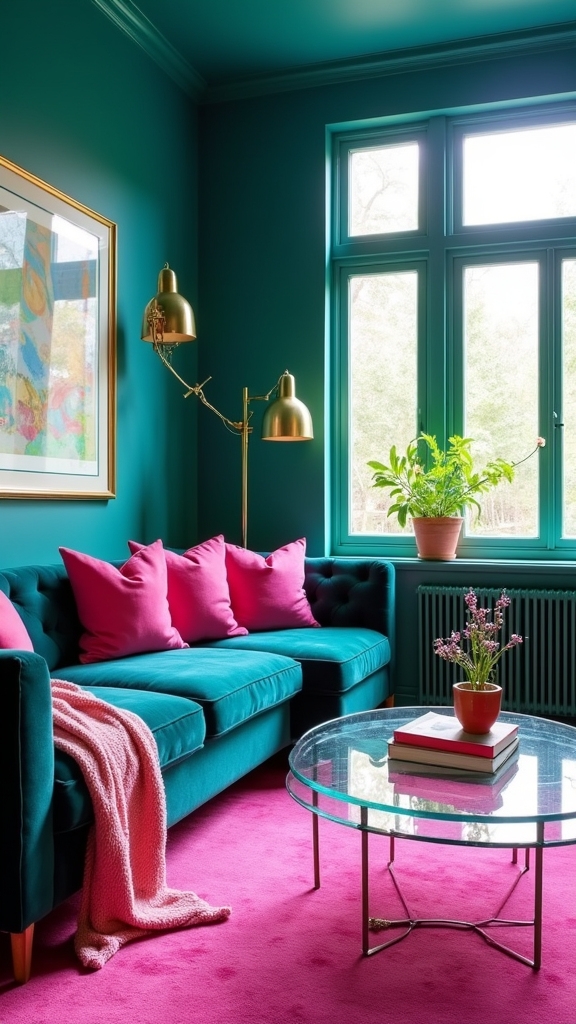
A fusion of teal and bubblegum pink injects instant energy into contemporary living rooms, capturing the essence of playful maximalism. This color pairing is distinguished by its ability to evoke both vibrancy and whimsy, transforming casual spaces into inviting, trend-forward environments. Teal’s saturated depth acts as a sophisticated anchor, while bubblegum pink provides dynamic contrast through accent pillows, artwork, or decorative accessories. To prevent visual overwhelm, designers often integrate neutral elements—such as crisp white trims or soft grey textiles—which temper the boldness and maintain balance. For a nuanced interplay, metallic or black accents can be introduced, elevating the youthful palette with a touch of elegance. This approach exemplifies current trends, where expressive color stories redefine the boundaries of modern living room aesthetics. Incorporating metallic accents can enhance the beauty of teal by adding sophistication and depth to the overall color scheme.
Teal and Mint Green
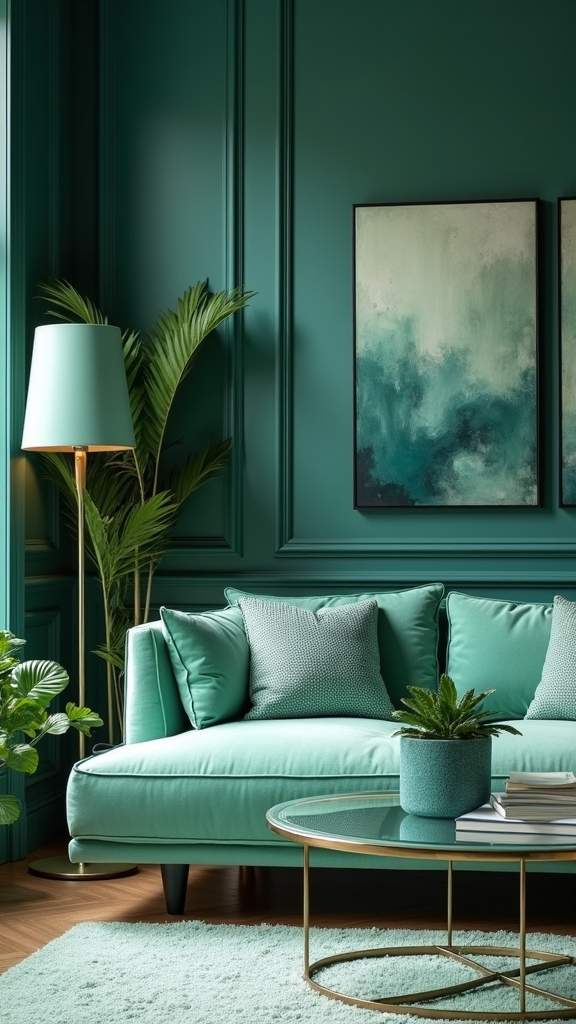
Palette cohesion defines the teal and mint green living room, where nuanced layering of analogous hues establishes a tranquil yet polished ambiance. Teal serves as the sophisticated anchor, while mint green, its lighter counterpart, injects freshness and modernity into the color narrative. Together, these shades foster a harmonious environment ideal for serene sitting rooms.
Integration of organic elements—such as leafy botanical prints and lush greenery—deepens visual interest and warmth, while light wood furnishings and neutral accents further promote an airy, cohesive aesthetic. Mint green accessories like cushions or art pieces provide playful contrast against teal upholstery, balancing elegance with approachability.
- Layer teal sofas with mint green cushions for visual intrigue
- Incorporate botanical prints to amplify natural undertones
- Select light wood furniture for enhanced cohesion
- Use mint green art to punctuate teal-dominated spaces
Teal and Bright White
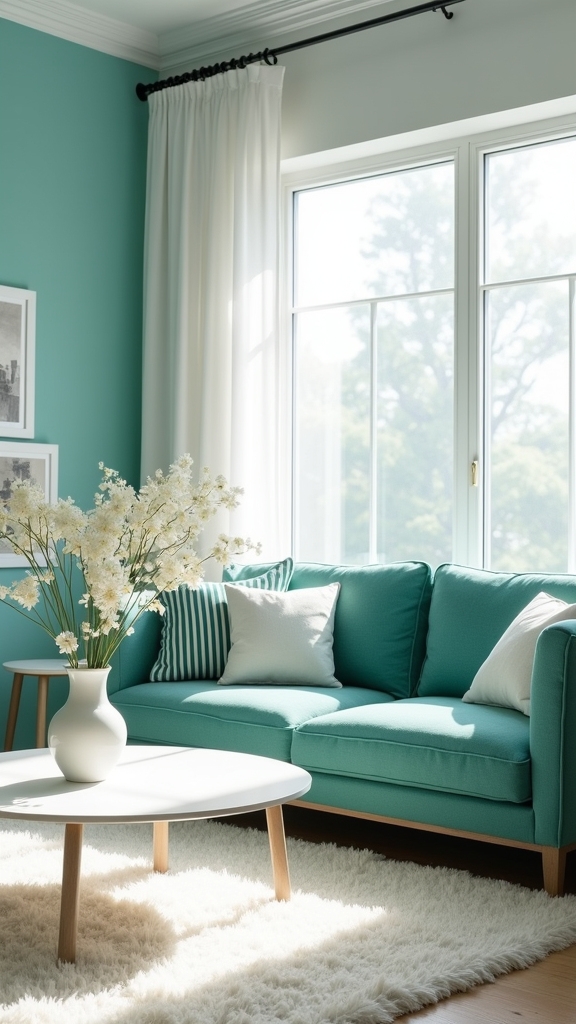
When juxtaposed with bright white, deep teal achieves maximum visual impact, its saturated tones invigorated by the crispness of the surrounding neutral. This dynamic pairing heightens the richness of teal, transforming it into a striking focal point that endows living spaces with contemporary appeal.
Bright white accents—be they architectural trim, moldings, or streamlined furniture—introduce clarity and balance, subduing the intensity of teal to foster an ambiance that is both fresh and inviting.
In design-forward settings such as mudrooms or entryways, the interplay of teal and bright white sets a welcoming, uplifting tone. Layering in rustic wooden elements against this backdrop adds tactile warmth, highlighting the sophisticated contrast while grounding the overall aesthetic in approachable elegance.
This scheme exemplifies enduring modernity.
Teal furniture, such as a plush teal sofa, serves as a vibrant centerpiece, anchoring room decor and elevating the space with its bold color.
Teal and Lime Green
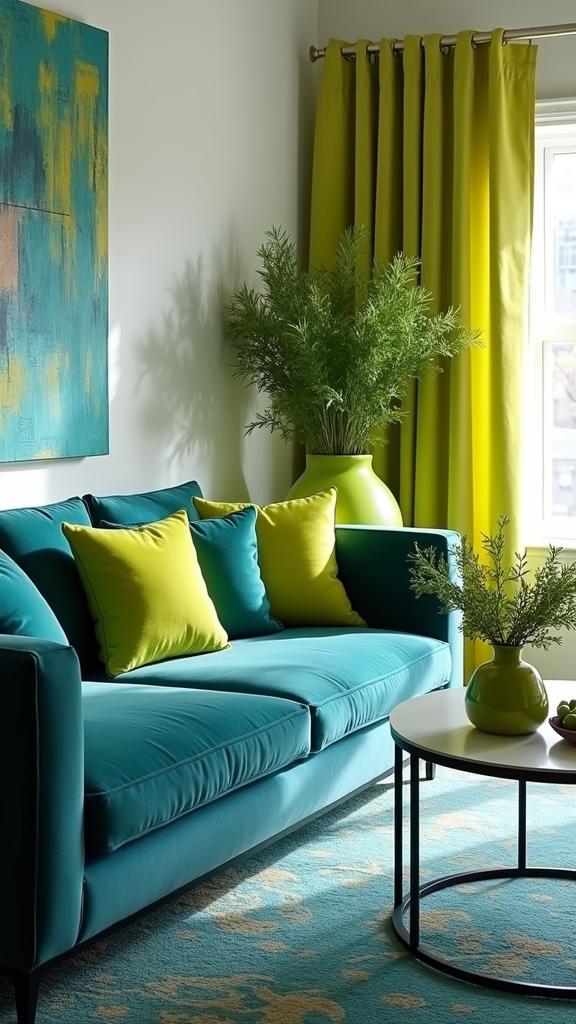
Moving beyond the crisp interplay of teal and bright white, pairing teal with lime green infuses living rooms with kinetic energy and modern sophistication.
This dynamic color scheme leverages the striking contrast between teal’s depth and lime green’s zesty vibrancy, establishing a visually arresting environment. The trend is especially prominent in contemporary interiors, where bold hues serve as focal points and amplify spatial drama.
High-gloss teal walls juxtaposed with lime green accents—think cushions or art—create a luminous, invigorating atmosphere. For balance, elements like natural wood and lush houseplants temper the color intensity while introducing organic warmth.
This palette excels in playful, creative zones, supporting both visual stimulation and a spirited ambiance.
- High-gloss teal walls for dramatic impact
- Lime green accessories to enhance vibrancy
- Natural wood pieces for grounding warmth
- Houseplants for textural and chromatic balance
Eco-friendly designs are increasingly being integrated into living room decor, making sustainable choices a popular trend in modern interior design.
Teal and Tangerine Orange
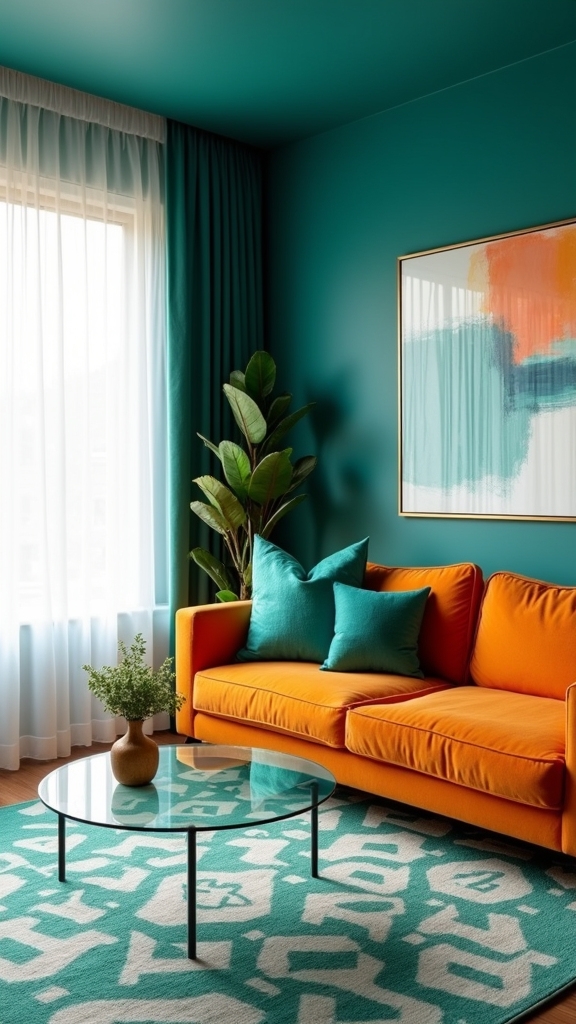
The interplay of teal and tangerine orange introduces a striking balance of vibrancy and warmth, infusing the living room with both energy and approachability.
Strategic use of white decor elements—such as trim, textiles, or modern furnishings—serves to temper the bold palette, ensuring visual clarity and cohesion.
This trend-forward combination appeals to those seeking a playful yet curated aesthetic in contemporary interiors.
Balancing Vibrancy and Warmth
A dynamic interplay between teal and tangerine orange introduces an energetic palette that instantly enlivens a living room. This striking combination leverages the inherent vibrancy of both hues—teal’s cool sophistication and tangerine’s radiant warmth—to establish a contemporary yet inviting atmosphere.
The juxtaposition is expertly balanced: tangerine’s warm undertones counter teal’s tranquil coolness, producing a harmonious contrast that remains visually engaging without overwhelming the senses. Current design trends favor such bold color pairings, especially when layered with tactile elements and thoughtful color placement.
- Pair teal walls with tangerine accent cushions or throws for focused vibrancy.
- Integrate geometric or abstract patterns to unify the color story.
- Employ varied textures—velvet, linen, or wool—for added depth and tactile appeal.
- Use tangerine décor strategically to create dynamic focal points.
Accenting With White Decor
Crisp white accents inject clarity and cohesion into a teal and tangerine orange living room, elevating the high-energy palette with a modern, invigorating edge. White decor—whether sleek furniture or geometric ceramics—serves as a visual anchor, tempering vibrancy and highlighting the interplay between teal and tangerine. In contemporary settings, white walls amplify natural light, allowing bold hues to command attention without overwhelming the space. Pairing with grey accessories introduces a subtle, sophisticated undertone, while neutral touches in beige or light wood add layered depth. The interplay of materials, finishes, and color saturation cultivates a fresh, trend-forward ambiance.
| Element | Teal & Tangerine | White Accent |
|---|---|---|
| Sofa | Teal velvet | White throw |
| Rug | Tangerine print | White fringe |
| Wall | Grey, white walls | White gallery art |
| Table | Light wood | White ceramic |
| Lighting | Brass fixture | White shade |
Teal and Pale Blue
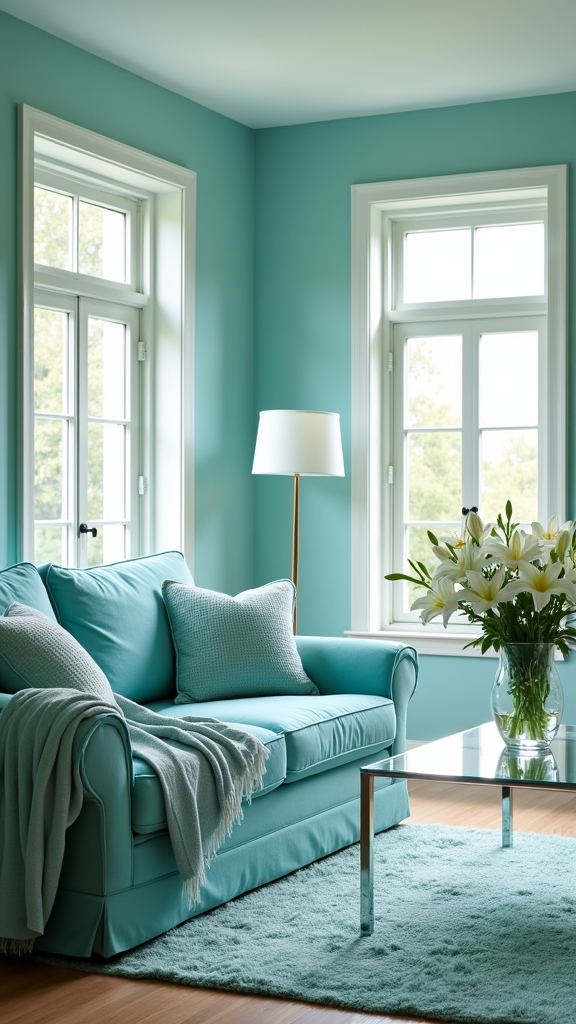
A teal and pale blue palette introduces a tranquil, coastal sensibility, ideal for fostering serenity in contemporary living spaces.
Layering cool blue tones achieves nuanced visual depth, while pairing these hues with natural textures such as rattan and lush greenery echoes current biophilic design trends.
This sophisticated combination is particularly suited to relaxed sitting rooms, where an airy, inviting ambiance is paramount.
Coastal Vibes and Serenity
Serenity defines the interplay between teal and pale blue, a pairing that channels the tranquility of ocean vistas and open skies. This color scheme delivers unmistakable coastal vibes, establishing a restful ambiance ideal for contemporary or classic living rooms.
Teal accents—whether in textiles, artwork, or statement furnishings—add dimensionality against the soft backdrop of pale blue walls, balancing visual depth with a soothing palette. Modern coastal interiors often integrate organic textures and subtle gloss to further accentuate this harmonious pairing.
- Incorporate rattan or wicker furniture to reinforce the coastal aesthetic and add tactile interest.
- Introduce leafy plants for a natural accent that complements the blue-green spectrum.
- Use soft fabrics and glossy finishes to layer visual and tactile depth.
- Opt for minimalist décor to maintain an uncluttered, breezy feel.
Layering Cool Blue Tones
When layered with intention, teal and pale blue establish a sophisticated chromatic dialogue that transforms living spaces into visually expansive and calming environments.
The interplay between these cool hues leverages color theory, using pale blue as a luminous backdrop to enhance the depth and vibrancy of teal accents. This approach to layering teal with pale blue cultivates a seamless gradient, evoking coastal and tropical aesthetics that are both on-trend and timeless.
Strategic placement—such as pale blue walls with teal furnishings or textiles—enhances spatial perception, making rooms feel airier. Current design preferences favor this palette for its ability to balance boldness and tranquility.
Incorporating varied textures—plush fabrics, smooth surfaces—within this scheme further boosts visual interest while maintaining a serene, unified atmosphere.
Pairing With Natural Textures
Textural contrast defines the synergy between teal and pale blue when integrated with natural materials, producing a living room aesthetic that is both sophisticated and grounded.
This palette, inspired by coastal serenity, is heightened by the thoughtful inclusion of natural textures—rattan, wood, linen—that foster a tactile interplay and visual warmth. The combination allows deep teal to anchor the space, while pale blue introduces an airy, light-infused dimension.
Layering soft fabrics and subtle metallic finishes guarantees depth without sacrificing tranquility. Incorporating greenery enhances the organic narrative, reinforcing a harmonious, biophilic environment.
- Rattan furniture and wooden accents amplify the natural textures alongside teal and blue.
- Soft textiles, such as linen and cotton, introduce comfort and layered interest.
- Metallic elements provide contemporary visual punctuation.
- Greenery integrates seamlessly, invigorating the calming palette with life.
Teal and Cognac
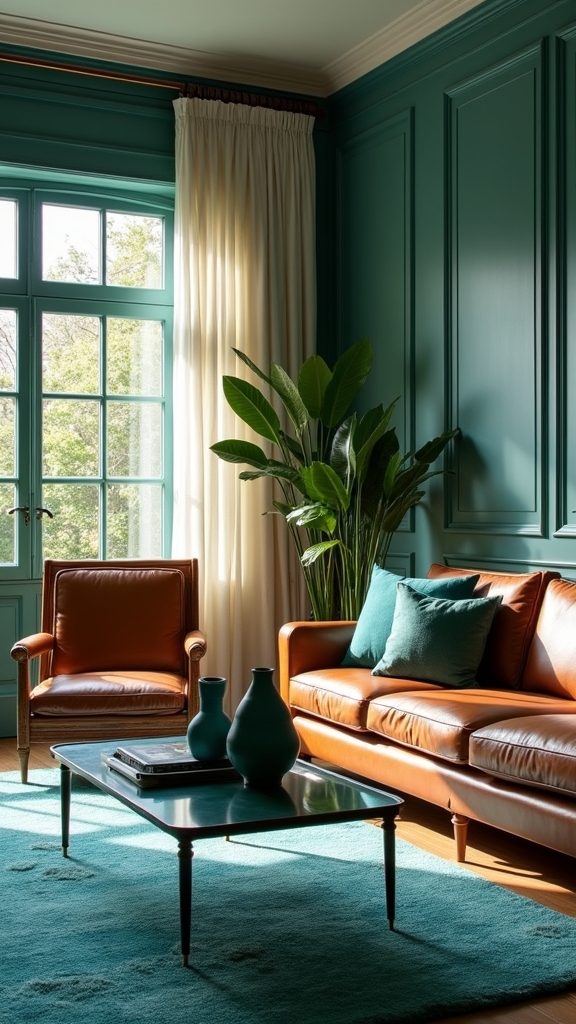
A dynamic interplay of color defines the teal and cognac living room scheme, where deep teal establishes a rich, sophisticated backdrop for the warm undertones of cognac leather or wood accents.
This pairing is celebrated in both classic and contemporary interiors, as teal and cognac combine to evoke an ambiance that feels both luxurious and inviting.
Strategically placed cognac furnishings or decor elements against teal walls or upholstery introduce depth and a grounded sensibility.
The juxtaposition of these hues benefits from metallic accents—such as brass or gold—which inject a current, glamorous edge and reflect light effectively.
To prevent visual heaviness, designers often incorporate neutral tones like cream or beige, ensuring the teal and cognac palette remains balanced, harmonious, and visually compelling within the living space.
Teal and Navy Blue
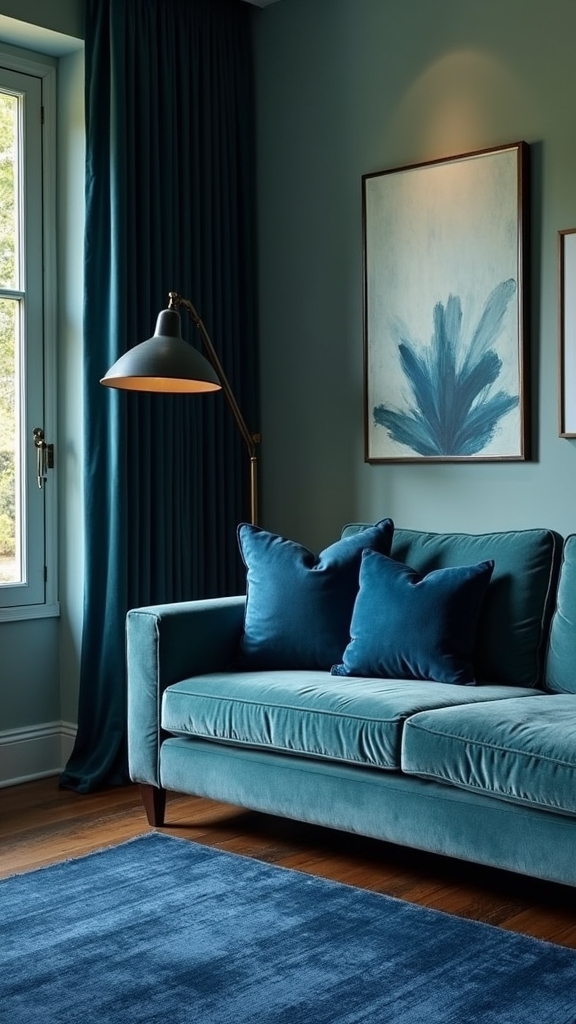
Balancing deep blue tones such as teal and navy requires strategic placement and thoughtful contrast to prevent visual heaviness in the living room.
Expert designers recommend layering tactile materials—think velvet upholstery, woven throws, and matte ceramics—to introduce depth and dimensionality within the blue palette.
This approach not only highlights the nuanced interplay between the hues but also aligns with current trends favoring sophisticated, multi-textured interiors.
Balancing Deep Blue Tones
Few color combinations rival the sophistication achieved by pairing teal with navy blue in contemporary living rooms. This dynamic duo delivers a striking balance, where navy blue’s depth provides an anchoring foundation, and teal injects a sense of vibrancy and modernity.
Designers often leverage this interplay to create interiors that are simultaneously bold and soothing, ideal for both relaxation and social gatherings. The integration of teal and navy blue is enhanced through thoughtful placement and complementary accents, maximizing their visual synergy.
- Use navy blue on major surfaces—such as accent walls or sectionals—to ground the space and set a refined tone.
- Introduce teal through statement decor, like cushions, vases, or artwork, for targeted pops of color.
- Enhance the palette with metallic finishes, especially gold or brass, to amplify luxury.
- Incorporate subtle patterns to unify the tones harmoniously.
Layering Textures for Depth
Texture serves as a key design element when merging teal and navy blue in a modern living room, providing dimensionality and tactile richness that enhance the scheme beyond color alone.
Layering textures—such as pairing plush teal velvet or chenille textiles with structured navy leather upholstery—cultivates visual depth and sophistication. Soft furnishings in patterned fabrics that integrate both shades foster cohesion, balancing bold contrasts with a soothing ambiance.
Strategically, navy blue functions as a stabilizing hue for larger furniture, while teal accents appear in vases, art, or decorative objects for playful elegance. The interplay between matte teal wall finishes and glossy navy blue accessories further raises the textural dynamic.
This expert approach to layering textures guarantees the living space feels both inviting and visually compelling.
Frequently Asked Questions
What Color Goes Well With Teal in a Living Room?
When selecting accent colors for a living room, designers often pair teal with mustard yellow, blush pink, deep burgundy, navy blue, or vibrant orange. These combinations offer visual contrast, contemporary appeal, and enhance the space’s overall atmosphere.
What Color Best Compliments Teal?
When considering what color best compliments teal, designers frequently select mustard yellow for its high chromatic contrast. This pairing with teal accents creates visual vibrancy, aligning with current trends favoring bold color blocking and dynamic, layered interiors.
Is Teal a Soothing Color?
Teal Psychology suggests teal is inherently soothing, merging the tranquility of blue with the restorative qualities of green. Visually, its balanced chromatic presence aligns with current wellness design trends, promoting relaxation and serenity in contemporary interior environments.
What Colours Make a Room Feel Cosy?
To create a cozy room, designers favor warm accents such as deep reds, burnt oranges, and soft yellows, layered with earthy neutrals and tactile textures. Current trends emphasize plush textiles and warm wood finishes for inviting, multidimensional spaces.
Conclusion
A teal living room offers dynamic versatility, seamlessly pairing with both vibrant and muted hues for a sophisticated effect. Whether juxtaposed with eggplant purple for depth, mustard for warmth, or blush pink for softness, teal acts as a unifying thread. Designers increasingly favor this color for its balance of boldness and tranquility, making it a mainstay in contemporary interiors. These curated schemes prove teal’s enduring appeal in crafting visually compelling, on-trend living spaces that feel both modern and inviting.
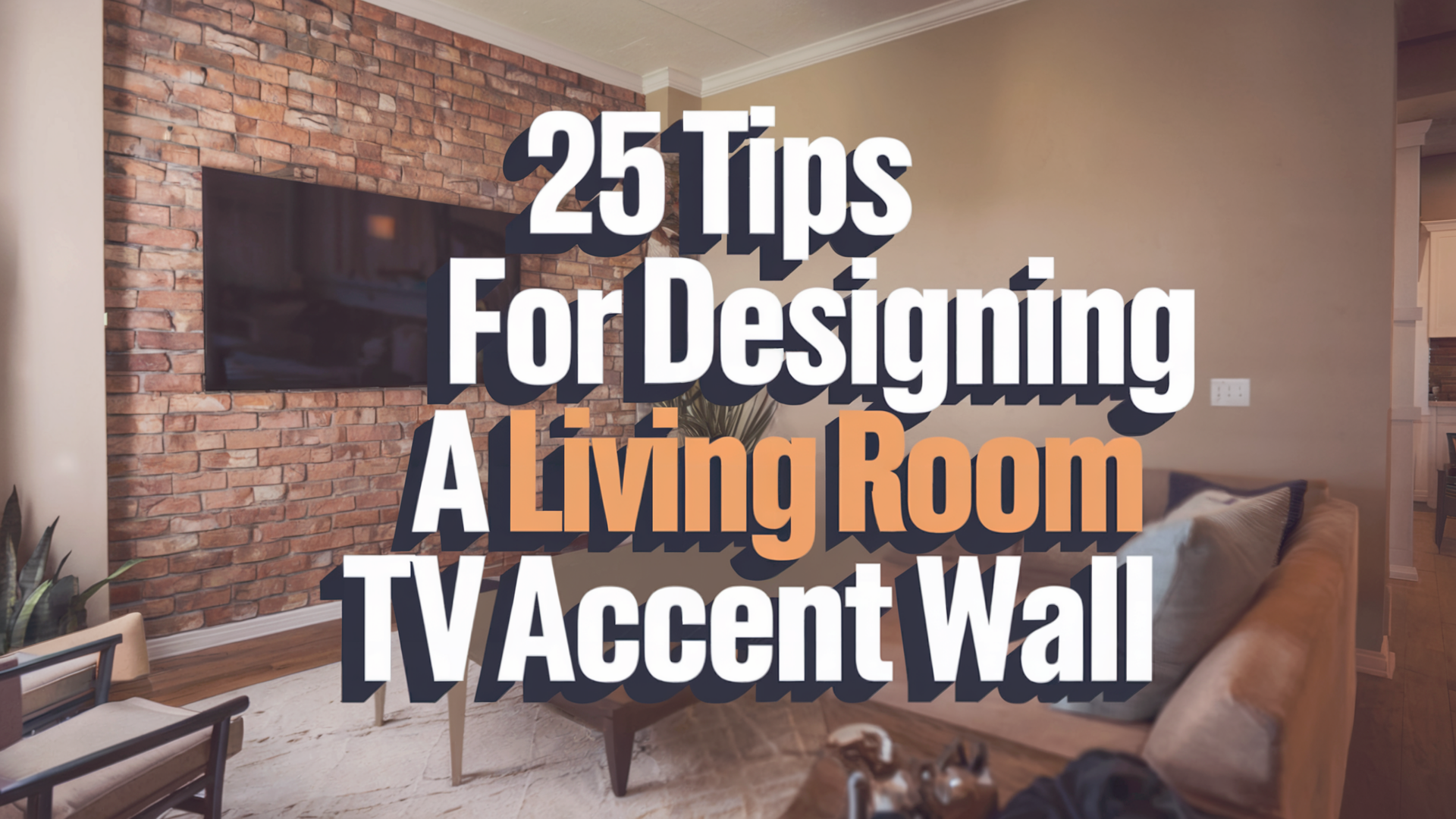
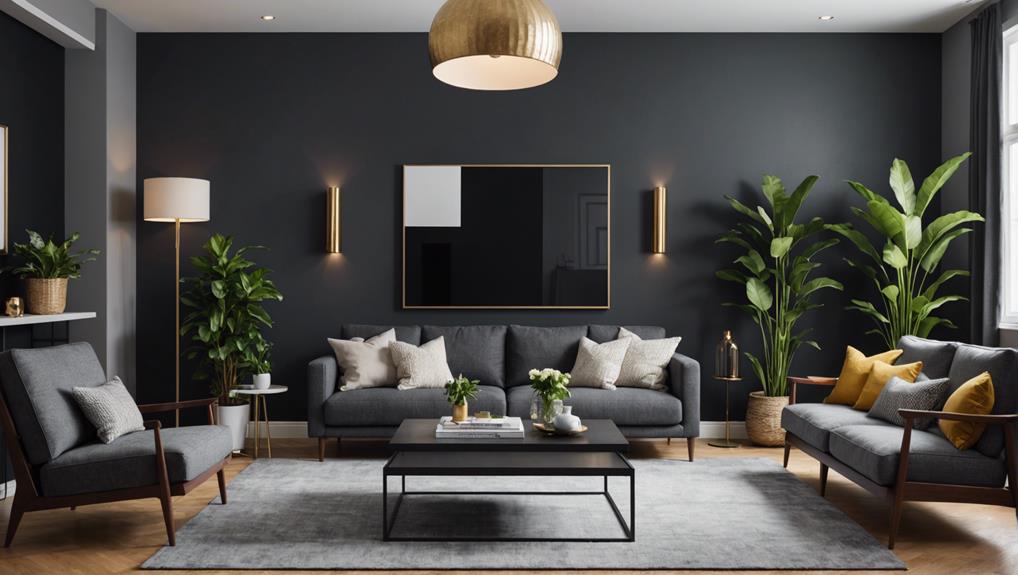
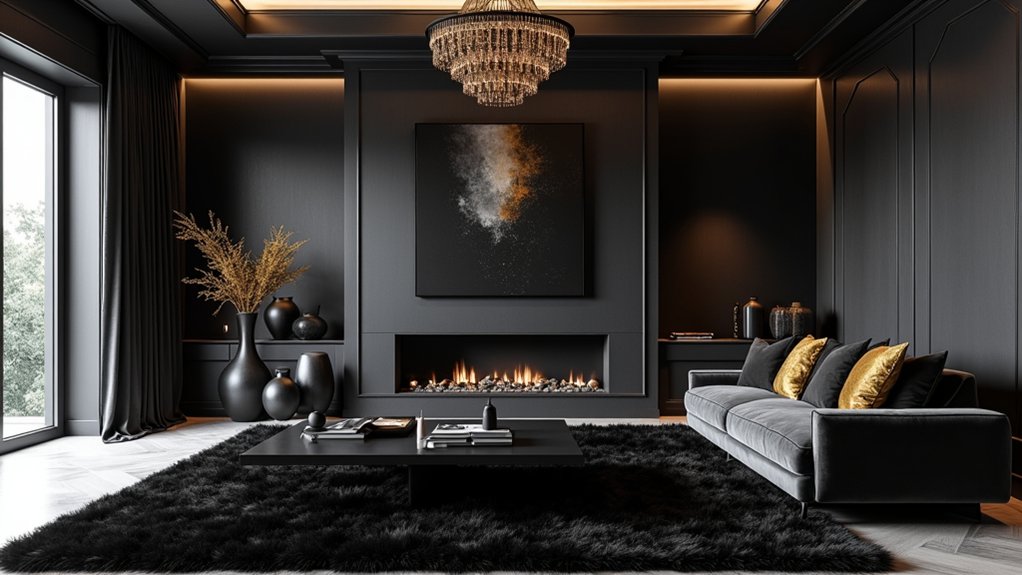
Leave a Reply